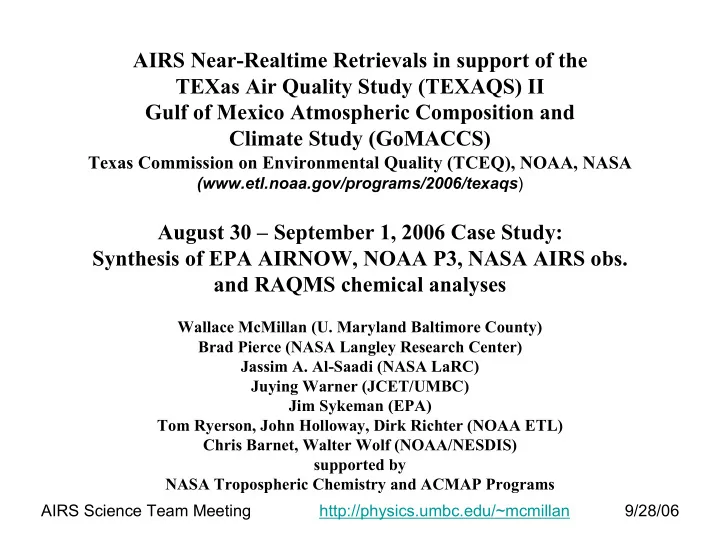

AIRS Near-Realtime Retrievals in support of the TEXas Air Quality Study (TEXAQS) II Gulf of Mexico Atmospheric Composition and Climate Study (GoMACCS) Texas Commission on Environmental Quality (TCEQ), NOAA, NASA (www.etl.noaa.gov/programs/2006/texaqs ) August 30 – September 1, 2006 Case Study: Synthesis of EPA AIRNOW, NOAA P3, NASA AIRS obs. and RAQMS chemical analyses Wallace McMillan (U. Maryland Baltimore County) Brad Pierce (NASA Langley Research Center) Jassim A. Al-Saadi (NASA LaRC) Juying Warner (JCET/UMBC) Jim Sykeman (EPA) Tom Ryerson, John Holloway, Dirk Richter (NOAA ETL) Chris Barnet, Walter Wolf (NOAA/NESDIS) supported by NASA Tropospheric Chemistry and ACMAP Programs AIRS Science Team Meeting http://physics.umbc.edu/~mcmillan 9/28/06
AIRS for TEXAQS • Greater Houston area is home to a substantial portion of the United States petrochemical processing facilities • Near-realtime AIRS CO and O3 maps, data, and trajectory forecasts to support daily flight planning – NOAA server NRT – GES DISC archive and NRT • Rapid Science Synthesis (RSS) to support development of Texas State Implementation Plan (SIP) for EPA – First draft due October 31, 2006! – Final version due early 2007 to EPA – AIRS CO addresses two of six critical questions regarding impacts of distance sources and background on Texas air quality • Surface sites, numerous NOAA, NASA, and Texas aircraft, several models, AIRS, MISR, TES • TEXAQS, INTEX-A, INTEX-B maps and data online: http://physics.umbc.edu/~mcmillan AIRS Science Team Meeting http://physics.umbc.edu/~mcmillan 9/28/06
AIRS Science Team Meeting http://physics.umbc.edu/~mcmillan 9/28/06
AIRS Science Team Meeting http://physics.umbc.edu/~mcmillan 9/28/06
AIRS Science Team Meeting http://physics.umbc.edu/~mcmillan 9/28/06
AIRS Science Team Meeting http://physics.umbc.edu/~mcmillan 9/28/06
AIRS Science Team Meeting http://physics.umbc.edu/~mcmillan 9/28/06
AIRS Science Team Meeting http://physics.umbc.edu/~mcmillan 9/28/06
AIRS Science Team Meeting http://physics.umbc.edu/~mcmillan 9/28/06
RAQMS Model Predicted Regional Influence On Houston Ozone Air Quality Event (8/30-9/2/06) 24hr averaged ozone shows 30ppbv enhancement during the period that could be due to regional transport Courtesy of Brad Pierce, TEXAQS RSS Presentation 9/15/06
Flow transition from On-shore to Northeasterly 08/29/06 08/30/06 Houston surface (red) and 850mb (blue) 5-day back trajectories Courtesy of Brad Pierce, TEXAQS RSS Presentation 9/15/06
5-day Lagrangian mean ozone mixing ratio, altitude, and pbl height Houston AIRNOW sites 09/01/06 Daily ozone production along back trajectories results in Lagrangian mean ozone increase of nearly 30ppbv during previous 4 days Trajectories remain within boundary layer during previous 5 days Courtesy of Brad Pierce, TEXAQS RSS Presentation 9/15/06
Model Verification: RAQMS vs P3 (Holloway) CO 08/31/06 NOAA P3 measurements provide NW US fires verification of regional scale predictions and satellite measurements LA/AR fires RAQMS overestimates Eastern BL CO enhancement A B (A) by 50% but does a reasonable job predicting enhancements in background CO on western portion of P3 flight (B). CO enhancements due to local biomass burning and Houston are not predicted due to coarse model resolution Courtesy of Brad Pierce, TEXAQS RSS Presentation 9/15/06
Near field Boundary Layer Wildfire Influences 20060831 (Ensemble average emission rates computed from 0-48 hr wildfire trajectories found within boundary layer) Observed, finescale boundary layer CO enhancements along P3 flight track are influenced by recent local biomass burning in Northern Louisiana. Courtesy of Brad Pierce, TEXAQS RSS Presentation 9/15/06
AIRS vs RAQMS Total Column CO 20060831 (AIRS verticality function applied to RAQMS) AIRS provides verification of model predictions and a regional context for P3 measurements: CO, O 3 , H 2 O, Temperature Courtesy of Brad Pierce, TEXAQS RSS Presentation 9/15/06
RAQMS retrieved CO column is highly correlated (r=0.78) with AIRS CO column over CONUS but has a slight (0.08x10 18 mol/cm 2 ) high bias, particularly south of 35 o N Courtesy of Brad Pierce, TEXAQS RSS Presentation 9/15/06
v4.2 Research AIRS CONUS coverage during the NOAA P3 flight AIRS Science Team Meeting http://physics.umbc.edu/~mcmillan 9/28/06
2014 AIRS at 1835 UTC High altitude plume mid-trop deficit AIRS Science Team Meeting http://physics.umbc.edu/~mcmillan 9/28/06
Best comparison when P-3 is near 500 mb (6 km) where AIRS is most sensitive AIRS Science Team Meeting http://physics.umbc.edu/~mcmillan 9/28/06
AIRS Science Team Meeting http://physics.umbc.edu/~mcmillan 9/28/06
upper tropospheric enhancement AIRS Science Team Meeting http://physics.umbc.edu/~mcmillan 9/28/06
stratospheric influence AIRS Science Team Meeting http://physics.umbc.edu/~mcmillan 9/28/06
stratospheric influence AIRS Science Team Meeting http://physics.umbc.edu/~mcmillan 9/28/06
AIRS Science Team Meeting http://physics.umbc.edu/~mcmillan 9/28/06
2014 AIRS at 1835 UTC AIRS Science Team Meeting http://physics.umbc.edu/~mcmillan 9/28/06
stratospheric influence dry pocket AIRS Science Team Meeting http://physics.umbc.edu/~mcmillan 9/28/06
stratospheric influence AIRS Science Team Meeting http://physics.umbc.edu/~mcmillan 9/28/06
Summary • Synthesis of Houston AIRNOW, NOAA P3, NASA AIRS measurements, and RAQMS predictions: – Demonstrates impact of distant sources to Houston air quality. – AIRS provides regional context for interpretation of ground and airborne measurements. – Model and trajectory analysis provides link between local air quality and regional observations. – Comparisons to P3 guide interpretation of model predictions and AIRS observations. • Integration of AIRS multiple specie retrievals is critical to geophysical interpretation – Models and in situ guide our understanding AIRS Science Team Meeting http://physics.umbc.edu/~mcmillan 9/28/06
Recommend
More recommend